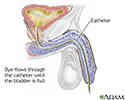Radionuclide cystogram
Nuclear bladder scan
A radionuclide cystogram is a special imaging test called a nuclear scan . It checks how well your bladder and urinary tract work.
Nuclear scan
A positron emission tomography scan is a type of imaging test. It uses a radioactive substance called a tracer to look for disease in the body. A po...

How the Test is Performed
The specific procedure may vary slightly depending on the reason for the examination.
You will lie on a scanner table. After cleaning the urinary opening, the health care provider will place a thin, flexible tube, called a catheter, through the urethra and into the bladder. A liquid containing radioactive material flows into the bladder until the bladder is full or you say that your bladder feels full.
The scanner detects radioactivity to check your bladder and urinary tract. When the scan is done depends on the suspected problem. You may be asked to urinate into a urinal, bedpan, or towels while being scanned.
To test for incomplete bladder emptying, images may be taken with the bladder full. Then you will be allowed to get up and urinate into the toilet and return to the scanner. Images are taken immediately after emptying the bladder.
How to Prepare for the Test
There is no special preparation needed. You will need to sign a consent form. You will be asked to wear a hospital gown. Remove jewelry and metal objects before the scan.
How the Test will Feel
You may feel some discomfort when the catheter is inserted. It may feel difficult or embarrassing to urinate while being observed. You cannot feel the radioisotope or the scanning.
After the scan, you may feel slight discomfort for 1 or 2 days when you urinate. The urine may be slightly pink. Call your provider if you have ongoing discomfort, a fever, or bright red urine.
Why the Test is Performed
This test is done to see how your bladder empties and fills. It can be used to check for urine reflux or an obstruction in urine flow. It is most often done to evaluate patients with urinary tract infections, particularly children.
Normal Results
A normal value is no reflux or other abnormal urine flow, and no obstruction to the flow of urine. The bladder empties completely.
What Abnormal Results Mean
Abnormal results may be due to:
- Abnormal bladder response to pressure. This could be due to a nerve problem or other disorder.
-
Back flow of urine
(vesicoureteric reflux)
(vesicoureteric reflux)
Reflux nephropathy is a condition in which the kidneys are damaged by the backward flow of urine into the kidney.
 ImageRead Article Now Book Mark Article
ImageRead Article Now Book Mark Article - Blockage of the urethra (urethral obstruction). This is most commonly due to an enlarged prostate gland.
Risks
Risks are the same as for x-rays (radiation) and catheterization of the bladder.
There is a small amount of radiation exposure with any nuclear scan (it comes from the radioisotope, not the scanner). The exposure is less than with standard x-rays. The radiation is very mild. Nearly all the radiation is gone from your body in a short time. However, any radiation exposure is discouraged for women who are or might be pregnant.
Risks for catheterization include urinary tract infection and (rarely) damage to the urethra, bladder, or other nearby structures.
References
Elder JS. Vesicoureteral reflux. In: Kliegman RM, Behrman RE, Jenson HB, Stanton BF, eds. Nelson Textbook of Pediatrics. 19th ed. Philadelphia, PA: Elsevier Saunders; 2011:chap 533.
Fulgham PF, Bishoff JT. Urinary tract imaging: Basic principles. In: Wein AJ, ed. Campbell-Walsh Urology . 10th ed. Philadelphia, PA: Elsevier Saunders; 2011:chap 4.
-
Cystography - illustration
Cystography is a detailed study of the bladder, which uses a dye and X-rays. A catheter is inserted into the bladder in which the dye flows. When the bladder is full, the catheter is removed and the X-rays are taken. X-rays are also taken when the bladder is empty. The test is performed to check for the integrity of the bladder, determine the cause of infections and check for tumors or stones.
Cystography
illustration
-
Cystography - illustration
Cystography is a detailed study of the bladder, which uses a dye and X-rays. A catheter is inserted into the bladder in which the dye flows. When the bladder is full, the catheter is removed and the X-rays are taken. X-rays are also taken when the bladder is empty. The test is performed to check for the integrity of the bladder, determine the cause of infections and check for tumors or stones.
Cystography
illustration
Review Date: 1/21/2015
Reviewed By: Scott Miller, MD, urologist in private practice in Atlanta, GA. Also reviewed by David Zieve, MD, MHA, Isla Ogilvie, PhD, and the A.D.A.M. Editorial team.

